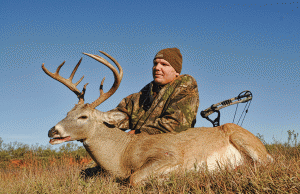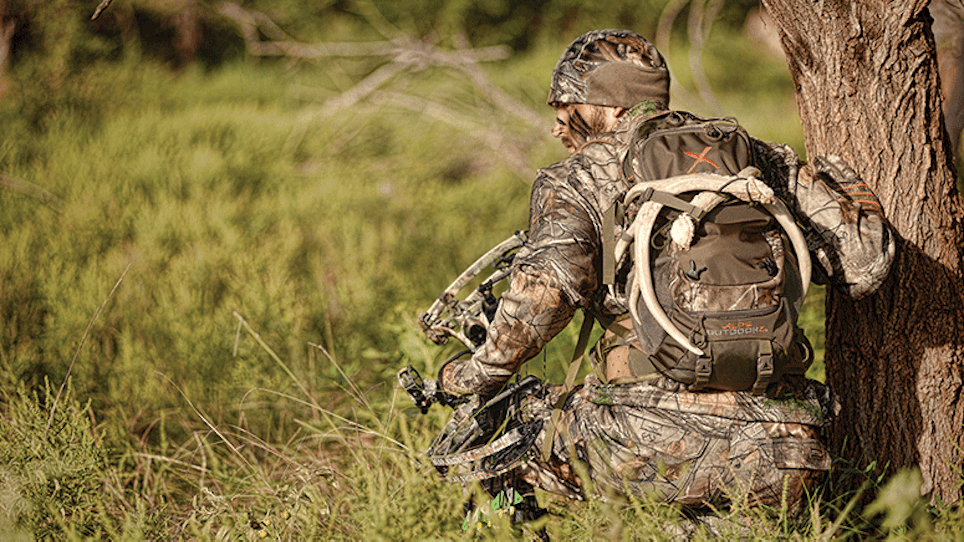October is always a tough time to hunt whitetails, and to be completely honest, I generally try to avoid it. But if I wanted to fill my Oklahoma tag this season, it would have to be during the week of the 15th; Kansas and Iowa would occupy my November affections. All I had to do was adjust to the current circumstances and hope something panned out.
I had done my fair share of scouting under the late August sun, and on more than one occasion observed a particular group of bucks using a fallow field under the summer’s fading light, but that had changed. Once the velvet was stripped off and testosterone levels began to rise, not even the remaining volunteer clover the field was offering was enough to draw any of them into view. All I was left with were a handful of nighttime trail camera photos that were flashing across my computer screen.
In a last ditch effort I decided to hunt the edge of the bedding area. The two main travel corridors leading to the south and west only yielded does and young bucks during those evening hunts, but I knew some mature bucks were still there. Although I had not seen a mature buck slip past in either location, trail camera photos taken just after last light had revealed otherwise.
Fading light always comes quicker under a heavy October canopy, and if it was going to happen it would have to be fast. Even with nearly 15 minutes of “legal” shooting light left, my ethical light was nearly gone. With thoughts of climbing down filtering through my mind and another October tag being mentally filed away in the unpunched stack, a shadowy form caught my attention. Its body size alone told me it was a buck; my 8x42s confirmed it. He wasn’t the top buck on my hit list, but he was in the mix, and when he paused squarely between a pair of trees, my green pin burned a hole in his chest.
The crack! of the arrow startled me at first, and when his back legs whirled around with a solid kick as he darted away, it was apparent my 20-yard pin was on the mark.
He wasn’t the biggest buck I had killed, nor the easiest, but ultimately killing Mister October generally never is.
Embrace The Changes
I’ll be the first to admit, October is not my favorite time to hunt whitetails. Although I have never been one to opine that mature bucks completely go “nocturnal” during this time of year, their behavior definitely changes, making it more difficult to find success. Deer are crepuscular, meaning they primarily move and feed most of the year during the low-light hours, and this is especially true during the summer months. This is really when mature bucks are most vulnerable to hunters as they travel to and from predictable feeding areas. However, this significantly changes in and around October, and if bowhunters want to capitalize on it, they must embrace this cycle of the deer season.
Although I’m not a deer biologist and most of my opinions on whitetail behavior come from anecdotal evidence and the research of others, I firmly believe there are several factors that characterize a buck’s changing behavior in October: breeding cycle/herd dynamics, food sources, personality and hunting pressure. All of these factors are significantly changing during this time of year in virtually every region of North America, and all of them are happening at once.
There is no question about it, most mature bucks will reduce their daytime activity significantly once the summer bachelor group pattern fizzles out. During this time bucks lose their velvet as their testosterone levels increase, and they become more territorial and start spreading out into their core fall areas. This is more a natural physiological change that is unavoidable and is not caused by anything hunters are or are not doing. Generally, bucks are not completely nocturnal during this time, but it seems they are when trail cameras only reveal mostly nighttime buck activity and you see very little activity during daylight hours.
Secondly, I believe a change in food sources is also a culprit in the reduction of daytime activity. Food sources drastically change as harvesting of summer crops takes place, as well as sowing of winter crops. Mast like acorns are falling in the timber then as well. These highly prized treats are generally closer to a buck’s bedding area, located in areas not as visible, which naturally causes mature bucks to appear less in open fields during daylight.
I also feel some bucks display more nocturnal behavior simply because it is their personality. Good or bad, mature bucks are individuals, and many have distinct personalities and survival traits. Some will display more daylight activity and some will be creatures of the night, and as hunters, there’s really not much we can do except wait for a particular buck to slip up, which is generally during the rut or late season.
Lastly, I believe human pressure also has a significant impact. Early October spells opening day for most bowhunters across the whitetail range, and this uptick in human activity, coupled with the other aforementioned factors, can significantly reduce visible daytime activity. Nothing will spook a mature buck more in his core area than human pressure, and even younger bucks and does won’t tolerate it long.
In fact, the Quality Deer Management Association (www.qdma.com) reported in a recent study that one hunter per 250 acres has a minimal effect on the way bucks move. However, buck behavior changed significantly with one hunter per 75 acres. Bucks chose thicker cover and tended to travel less, and the observation rates/hunter success decreased with the hunter impact on smaller properties. The study further reported that once the season opened, it only took three days for bucks to change their behavior.
October Details
With all of these factors considered, hunting in October can be a grind, but opportunities can be found during this changing transition season. While details are important regardless of when you step into the whitetail woods, they can be especially important in October.
It’s easy to find a buck’s preferred feeding area during the early and late seasons, but as food sources alter, so should your scouting efforts. Much of your success will be determined with how well you know the different food sources that are available. Whether it’s a simple crop rotation that has affected deer movement, acorn and other mast that is beginning to fall or browsing habits changing, knowing your property and where a buck is likely to be will help you narrow down your options. Although it takes some extra effort, knowing where your mast trees are and what the crop will produce any given year is important to narrowing down Mister October.
Trail cameras are an obvious tool this time of year, but checking them often does have an inherent risk. Regardless of how well you “manage” your scent, nothing is 100 percent. Although you may be tempted to move cameras deep into a buck’s core area in hopes of grabbing a shot, don’t be seduced; you may be doing more harm than good. Oftentimes, not getting photos can be just as important as getting them when it comes to eliminating potential areas.
While scouting you’ll not only be looking for the obvious deer sign, but you should also note human sign in and around your property. Although many feel that the land they solely control is not at risk to these outside influences, it is when you consider its size and the hunting pressure around it. Although you can’t completely control what goes on around your property, you do have sole control of how you interact with it.

A dedicated bowhunter and a true whitetail guru, the author put his October game plan into action and scored on this great Sooner State buck.
Keeping your impact in check will significantly increase your odds of success. Not only should you take advantage of scent-reducing clothing, sprays and electronic devices we have at our disposal, but utilizing good travel routes to and from your stand can pay huge October dividends. Take advantage of creeks, ditches and isolated thick hedge rows as traveling locations. Even if they create a longer route to your stand, these terrain features keep you hidden and reduce noise and scent detection.
Be choosy when picking your stand as well and don’t just jump into “old reliable.” Chances are the stands you’ve hunted during past Novembers are not nearly as good in October, and hunting them in October can make them duds in November. Take an outside-in approach when hunting Mister October, look for the subtle details of each hunt and adjust your approach accordingly. Because of all the changes taking place, nothing is foolproof this time of year, but capitalizing on the little details can provide an opportunity.
Weather is always a factor when bowhunting whitetails, and this is especially true in October. There’s nothing that will bring a mature buck to his feet quicker than a passing weather event. Even a drop in temperature of just five degrees coupled with a slight pressure change can pay dividends, especially if the temperature falls below the season’s historical average. Barometric changes occur as storms are moving into and out of an area, and when the barometer is between 29.80 and 30.29, it’s time to head to the woods.
Although misery loves company in the duck blind, it’s no fun when you’re strapped to a tree. Don’t let it dampen your spirits. In October, a steady light rain with light winds will increase daylight activity. The moisture in the air, coupled with cooler temperatures and falling pressure, will keep deer on their feet longer in the mornings, as well as get them moving earlier in the afternoons. As for those heavy storms, keep dry and wait for them to pass, but watch the radar. Hunting just after a downpour, especially one that lasts for hours, is always a good idea.
Lastly, my favorite areas to hunt this time of year are staging areas near food sources and the downwind edge of a bedding area, with the latter being the best option. These are spots where deer feel secure enough to be on their feet during daylight hours. Staging areas are generally next to a prime feeding or watering location that gives bucks a good opportunity to see where they want to be from a secure distance, and scent check it as well. Bedding areas offer a bit more risk of a hunter being detected for obvious reasons, but they are the best areas to hunt for Mister October. Look for funnels leaving these areas to better predict his travel route, and finding a well-used rub could be the clue you’re after.
I’m not going to lie, hunting for Mister October isn’t easy, and more times than not you’ll leave the woods wondering why you even tried in the first place. Even though the odds are stacked against you, if you embrace this changing transition season and consider your plan, slipping an arrow through him is a real possibility.






